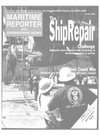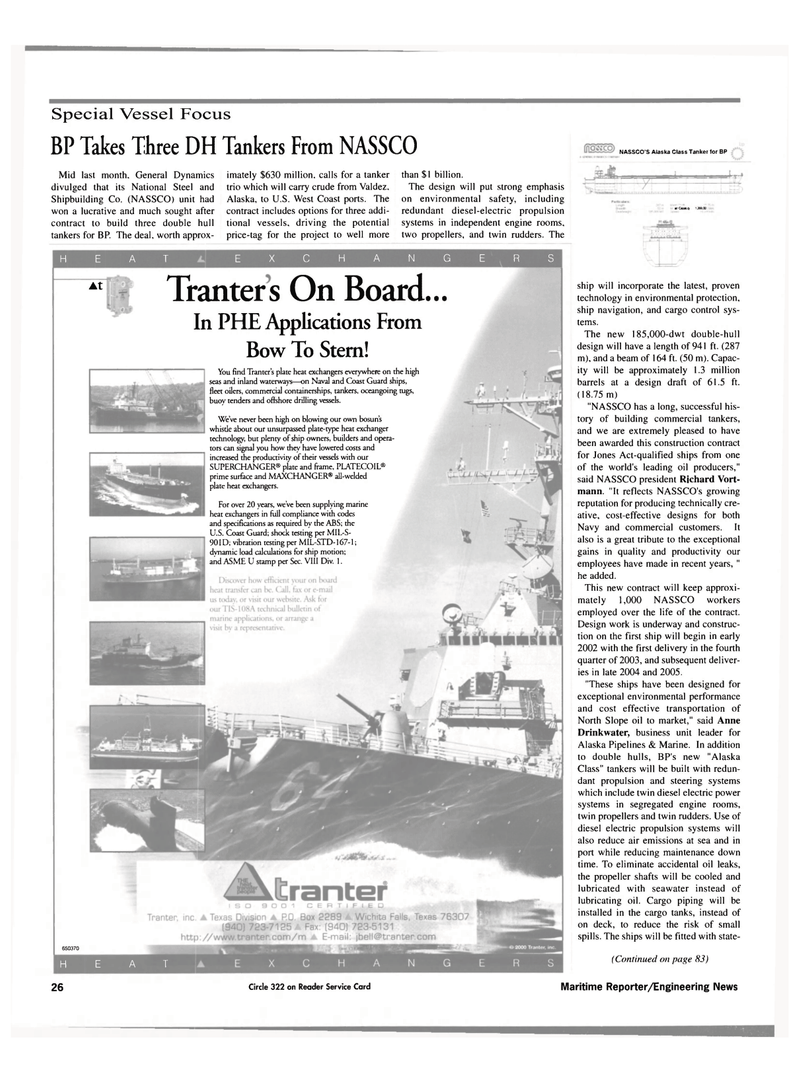
Page 26: of Maritime Reporter Magazine (October 2000)
Read this page in Pdf, Flash or Html5 edition of October 2000 Maritime Reporter Magazine
Special Vessel Focus
BP Takes Three DH Tankers From NASSCO
Mid last month. General Dynamics divulged that its National Steel and
Shipbuilding Co. (NASSCO) unit had won a lucrative and much sought after contract to build three double hull tankers for BP. The deal, worth approx- imately $630 million, calls for a tanker trio which will carry crude from Valdez.
Alaska, to U.S. West Coast ports. The contract includes options for three addi- tional vessels, driving the potential price-tag for the project to well more
H E A T A i! E X C H A N G E R S •t Tranters On Board...
In PHE Applications From
Bow To Stern!
You find Tranter's plate heat exchangers everywhere on the high seas and inland waterways—on Naval and Coast Guard ships, fleet oilers, commercial containerships, tankers, oceangoing tugs, buoy tenders and offshore drilling vessels.
We've never been high on blowing our own bosun's whisde about our unsurpassed plate-type heat exchanger technology, but plenty of ship owners, builders and opera- tors can signal you how they have lowered costs and increased the productivity of their vessels with our
SUPERCHANGER® plate and frame, PLATECOIL® prime surface and MAXCHANGER® all-welded plate heat exchangers.
For over 20 years, we've been supplying marine heat exchangers in full compliance with codes and specifications as required by the ABS; the
U.S. Coast Guard; shock testing per MIL-S- 90ID; vibration testing per MIL-STD-167-1; dynamic load calculations for ship motion; and ASME U stamp per Sec. VIII Div. 1.
NASSCO'S Alaska Class Tanker for BP than $1 billion.
The design will put strong emphasis on environmental safety, including redundant diesel-electric propulsion systems in independent engine rooms, two propellers, and twin rudders. The an Opacity 1.300,9) 650370
H E A T ship will incorporate the latest, proven technology in environmental protection, ship navigation, and cargo control sys- tems.
The new 185,000-dwt double-hull design will have a length of 941 ft. (287 m), and a beam of 164 ft. (50 m). Capac- ity will be approximately 1.3 million barrels at a design draft of 61.5 ft. (18.75 m) "NASSCO has a long, successful his- tory of building commercial tankers, and we are extremely pleased to have been awarded this construction contract for Jones Act-qualified ships from one of the world's leading oil producers," said NASSCO president Richard Vort- mann. "It reflects NASSCO's growing reputation for producing technically cre- ative, cost-effective designs for both
Navy and commercial customers. It also is a great tribute to the exceptional gains in quality and productivity our employees have made in recent years, " he added.
This new contract will keep approxi- mately 1,000 NASSCO workers employed over the life of the contract.
Design work is underway and construc- tion on the first ship will begin in early 2002 with the first delivery in the fourth quarter of 2003, and subsequent deliver- ies in late 2004 and 2005. "These ships have been designed for exceptional environmental performance and cost effective transportation of
North Slope oil to market," said Anne
Drinkwater, business unit leader for
Alaska Pipelines & Marine. In addition to double hulls, BP's new "Alaska
Class" tankers will be built with redun- dant propulsion and steering systems which include twin diesel electric power systems in segregated engine rooms, twin propellers and twin rudders. Use of diesel electric propulsion systems will also reduce air emissions at sea and in port while reducing maintenance down time. To eliminate accidental oil leaks, the propeller shafts will be cooled and lubricated with seawater instead of lubricating oil. Cargo piping will be installed in the cargo tanks, instead of on deck, to reduce the risk of small spills. The ships will be fitted with state- (Continued on page 83) 26 Circle 322 on Reader Service Card Maritime Reporter/Engineering News

 25
25

 27
27
